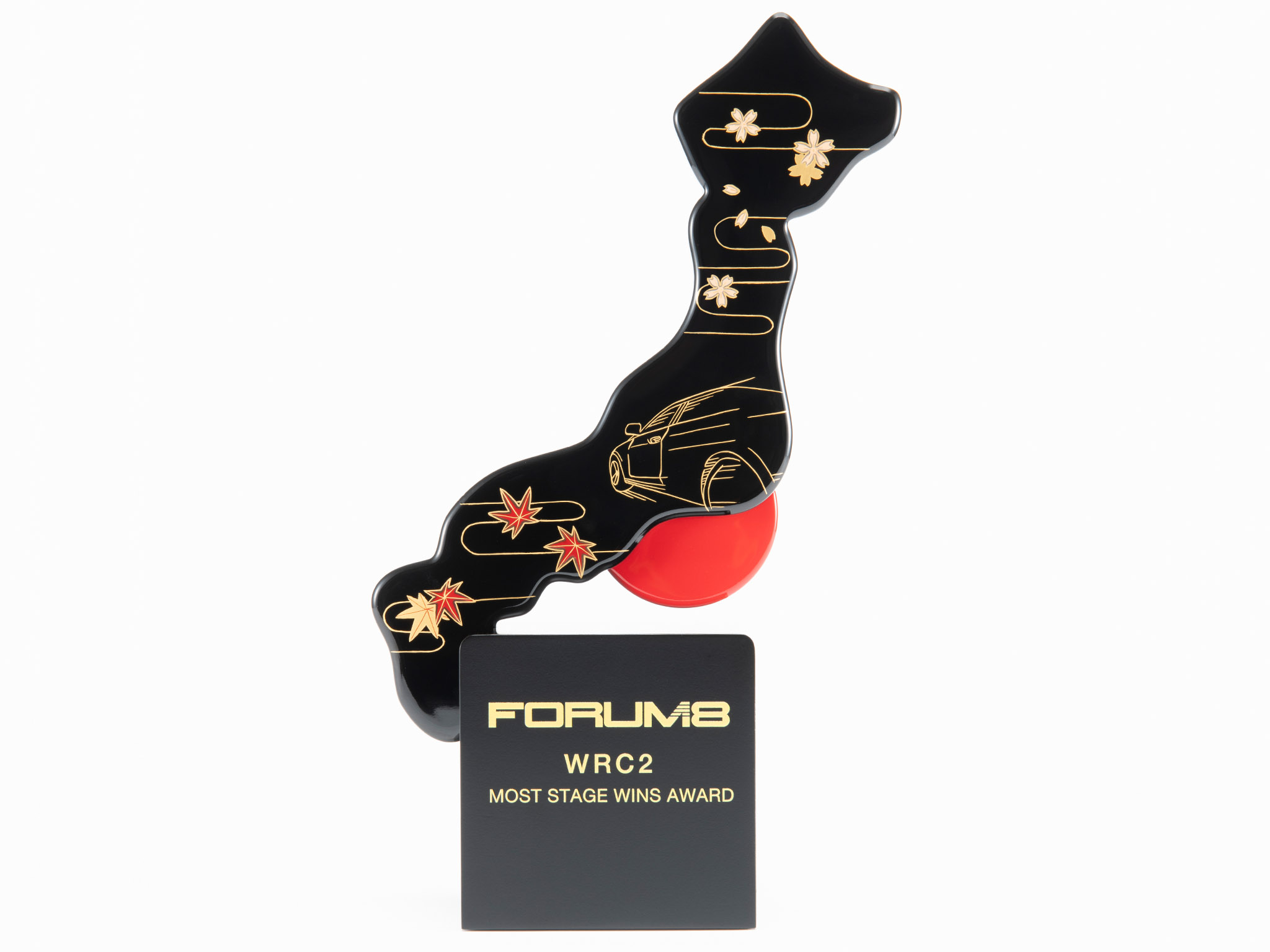FIA World Rally Championship WRC2 Trophy

We worked on the FORUM8 trophy for WRC2 with the letters of each of the 14 races.
The “FORUM8 WRC2 Most Stage Wins Award” was established by Forum8 Inc. for the purpose of nurturing promising athletes aiming for the top level of WRC. As a Japanese company, they wanted to present a trophy that symbolizes Japan, so we proposed a hand-crafted trophy.
The trophy body is a deformed Japanese shape, and is cantilevered on a base so that it appears to be floating with a red circle. The chamfering was made larger, creating a plump, three-dimensional wooden base, and maki-e was applied using the same technique as used on Buddhist altars. Maki-e was done on cherry blossoms and autumn leaves, which is our specialty in Buddhist altar maki-e, in other words, spring and autumn were drawn at the same time to create an auspicious pattern that represents the seasons that never stop coming and going. We added a road and a car to the design to give it a meaning appropriate for WRC2, which will be a year-long battle.
| Title | FIA World Rally Championship WRC2 Trophy |
|---|---|
| Date | 2025.01 |
| Theme | trophy |
| Techniques | Wood, Coating, Maki-e Painting |
| Materials | MDF, Coating Body: Lacquer / Stand: Urethane coating, Maki-e Hand-painting : Lacquer, gold powder, Stand printing: Inkjet UV printing |
| Size | Height 28.5 cm, Width 17.0 cm, Depth 9.0 cm |
| Design | Yosuke Inui |
| Photography | Hiroshi Ohno |
Integrated traditional materials and techniques
Since the order was for multiple wooden pieces in the same form, and especially since the delivery date was very tight, the woodwork was ordered from a workshop that can handle laser cutting on short notice. The body painting, maki-e, and assembly were done in Hikone. Since we proposed to mount the trophy body so that it would float up from the base, we devised a simple but efficient and sufficiently strong joining method inside the stand.
Woodworking
Working with unfinished wood is an important initial process for creating the foundation or frame of a product.
Woodworking at INOUE is based on the exacting quality found in the traditional arts that have been cultivated by the production of Buddhist altars in the castle town of Hikone since the Edo Period (1603-1868 CE). Craftsmen produced these altars by hand and without nails, demanding uncompromising quality in the careful selection of the best materials for use in mortise and tenon construction. These altars are durable enough to be handed down through many generations. Furthermore, we have connections with woodworking shops in other areas that specialize in mass production, allowing us to select the appropriate methods of woodworking for any project.Maki-e
Maki-e is an artistic lacquer technique that involves drawing pictures or patterns using lacquer and then sprinkling them with gold dust or other fine powders. Maki-e originates in Japan and is one of the unique traditional techniques developed here. Maki-e includes many subsidiary techniques, such as hiramakie, takamakie, and togidashimakie. Furthermore, maki-e includes a wide variety of different end products, such as the expression of depth through different types or sizes of gold powder and the application of a variety of processing techniques.
At INOUE, we have built a network of maki-e craftsmen with a wide range of skills, allowing us to provide the skills needed for any project, from projects demanding the utmost quality to those needing to fit into a tight budget.Finishes (cashew, urethane, etc.)
At INOUE, the quality of our finishes is consistently and carefully scrutinized with a watchful eye. From sophisticated traditional techniques such as base coats of natural lacquer to cashew finishes made with the natural resin of the cashew tree, also a member of the lacquer family, to urethane finishes made with synthetic resins, we provide a wide variety of finishing techniques.
Given our extensive network of craftsmen with unparalleled technical skill, we can fulfill requests for finishes of nearly any kind.Design of traditional arts objects
In many ways, traditional arts objects are of an extremely high quality. However, as they are handmade, the scope of this quality differs in its conditions and limits from mass produced objects.
At INOUE, we collaborate with designers who have a deep knowledge of the traditional arts to handle new designs. This includes adjusting a design using their knowledge of each of the arts processes involved in a project’s production. We are also happy to receive inquiries for projects that are still in the design phase.